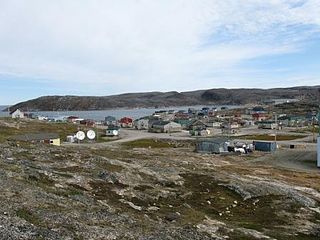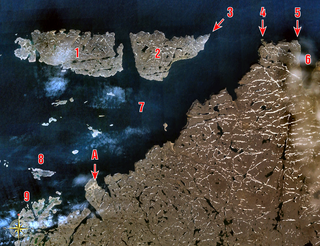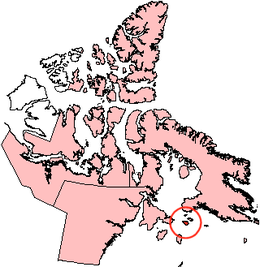
Pitseolak Ashoona, was an Inuk Canadian artist admired for her prolific body of work. She was also a member of the Royal Canadian Academy of Arts.

Somerset Island is a large, uninhabited island of the Arctic Archipelago, that is part of the Canadian territory of Nunavut. The island is separated from Cornwallis Island and Devon Island to the north by the Parry Channel, from Baffin Island to the east by Prince Regent Inlet, from the Boothia Peninsula to the south by Bellot Strait, and from Prince of Wales Island to the west by Peel Sound. It has an area of 24,786 km2 (9,570 sq mi), making it the 46th largest island in the world and Canada's twelfth largest island.

Coats Island lies at the northern end of Hudson Bay in the Kivalliq Region of Nunavut. At 5,498 km2 (2,123 sq mi) in size, it is the 107th largest island in the world, and Canada's 24th largest island.

Kinngait, formerly known as Cape Dorset until 27 February 2020, is an Inuit hamlet located on Dorset Island near Foxe Peninsula at the southern tip of Baffin Island in the Qikiqtaaluk Region of Nunavut, Canada.

Ivujivik is a northern village in Nunavik, Quebec, and the northernmost settlement in any Canadian province, although there are settlements further north in the territories. Its population in the Canada 2021 Census was 412. Unlike most other northern villages in Nunavik, it has no Inuit reserved land of the same name associated with it.
Moore Island is an uninhabited island in the Qikiqtaaluk Region, Nunavut, Canada. It is a member of the Belcher Islands group in Hudson Bay. It lies in Churchill Sound between Kugong Island to its west and the Howard Peninsula of Flaherty Island to its east with the Inuit community of Sanikiluaq about 30 km (19 mi) northeast.
Split Island is an uninhabited island in the Qikiqtaaluk Region, Nunavut, Canada. Located in Hudson Bay, it belongs to the North Belcher Islands, a sub-archipelago of the Belcher Islands group.

Peter Pitseolak (1902–1973) was an Inuk photographer, sculptor, artist and historian. Pitseolak was Baffin Island's first indigenous photographer.
The Ottawa Islands are a group of currently uninhabited islands situated in the eastern edge of Canada's Hudson Bay. The group comprises 24 small islands, located at approximately 60N 80W. The main islands include Booth Island, Bronson Island, Eddy Island, Gilmour Island, J. Gordon Island, Pattee Island, and Perley Island. The highest point is on Gilmour Island, which rises to over 1,800 ft (550 m). Located a short distance off the northwest coast of Quebec's Ungava Peninsula, they, like the other coastal islands in Hudson Bay, were historically part of the Northwest Territories, and became Crown Land upon the creation of Nunavut in 1999. Nunavik Inuit have occupied these islands since time immemorial and gained constitutionally-protected harvest and access rights under the Nunavik Inuit Land Claim Agreement signed in 2007.

Pitsiulartok or Pituilaktok is a small, uninhabited island located at 63°15'N, 90°33'W in Hudson Bay, about 13 km from the community of Chesterfield Inlet, Nunavut, Canada. The narrow island is about 3.5 km in length and barely 1 km wide at its widest point. Traditionally it was a walrus-hunting ground for the local Inuit, and a landmark for southern whalers. It is part of a loose chain of small islands running along the coast, including Sakpik Island and Promise Island.
Mill Island is an uninhabited Arctic island located in Hudson Bay between Foxe Channel and Hudson Strait. It is south of Baffin Island's Foxe Peninsula, and north of Nottingham and Salisbury islands. Mill Island is part of the Qikiqtaaluk Region of the Canadian territory of Nunavut.

The Digges Islands are members of the Arctic Archipelago in the territory of Nunavut. The two islands, West Digges and East Digges, are located in Digges Sound, an arm of Hudson Bay, where the strong currents of the bay meet Hudson Strait.
The uninhabited Point Islands are located in Hudson Strait's Diana Bay. Though they are near the Inuit hamlet of Quaqtaq, Quebec, they are part of the Qikiqtaaluk Region, in the Canadian territory of Nunavut.
Piling Bay is an uninhabited waterway in the Qikiqtaaluk Region, Nunavut, Canada. It is located on the west central coast of Baffin Island. An arm of the Foxe Basin, it contains many small, unnamed islands. Foley Island and North Tweedsmuir Island lie outside the mouth of the bay to the south/southwest.
Saarru formerly Alareak Island is an uninhabited island in the Qikiqtaaluk Region of Nunavut, Canada. It is a Baffin Island offshore island in Hudson Strait on the southwest side of Andrew Gordon Bay. It is situated at approximately 1 m above sea level.
Dexterity Island is an uninhabited island in the Qikiqtaaluk Region of Nunavut, Canada. It is located in Baffin Bay off the northeastern coast of Baffin Island. Adams Island is 19.3 km (12.0 mi) to the south, while Bergesen Island is 17.2 km (10.7 mi) to the west, across Isbjorn Strait.
Marble Island is one of several uninhabited Canadian arctic islands in Nunavut, Canada, located within western Hudson Bay. The closest community is Rankin Inlet. In the nineteenth century, the island was valued as a harbour for overwintering.
Fraser Island is an uninhabited island in the Qikiqtaaluk Region of Nunavut, Canada. It is located at the mouth of Hudson Bay off Nottingham Island's northwestern tip. The closest community is the Inuit hamlet of Kinngait, 120 km (75 mi) to the northeast on Baffin Island.
The Salikuit Islands are an uninhabited island group in the Qikiqtaaluk Region of Nunavut, Canada. The 103 island archipelago is located in eastern Hudson Bay between the Belcher Islands and the western coast of Quebec. The closest communities are the Inuit hamlets of Umiujaq, Quebec, 60 km to the east on the coast of Hudson Bay, and Sanikiluaq, 75 km (47 mi) to the west on Flaherty Island.
Walrus Island is an uninhabited Canadian arctic island in the Kivalliq Region, Nunavut. Located in Fisher Strait, it is situated between Southampton Island and Coats Island in northern Hudson Bay. Archaeological evidence indicates that the Sadlermiut were once active on the island.











